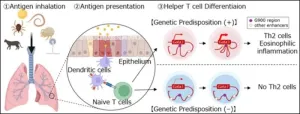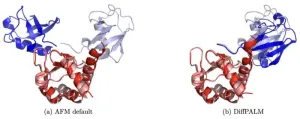(Press-News.org) Though exposure to “trace” (an extremely small amount) elements has been shown to affect ovarian functions in experimental studies, there has been little research on the impact of trace levels of non-essential elements, such as lead (Pb) and mercury (Hg), on female reproduction. Studies have shown that high levels of these non-essential elements may lead to decreased female fertility and reduce the likelihood of getting pregnant. Taken together, this evidence raises concern about the potential negative impact of exposure to trace levels of non-essential elements on human reproduction.
In a new study from George Mason University researchers and funded by the National Institute of Environmental Health Sciences (NIEHS), some trace elements measured in ovarian follicular fluid were associated with differences in ovarian response to in vitro fertilization (IVF), which in turn, may affect the chance of getting pregnant. Trace elements are measured in very small concentrations with units such as parts per million or parts per billion.
“By studying the association between trace elements and ovarian response to IVF, we aim to better understand factors that may influence conception. Ultimately, the goal is to provide guidance for patients and clinicians in strategies to improve their chances of a successful pregnancy in IVF treatment,” said Michael S. Bloom, the principal investigator and professor in the Department of Global and Community Health. “Associations between follicular fluid trace elements and ovarian response during in vitro fertilization” was published in the July 2024 issue of Environmental Research.
“This study is unique because we used follicular fluid which is in direct contact with the developing egg to measure concentrations of trace elements. We found that elements may play a beneficial or detrimental role in reproductive health through ovarian function,” said Rooshna Mohsin, first author and George Mason Ph.D. in Public Health student.
Higher concentrations of cobalt (Co) and copper (Cu) in ovarian follicular fluid were associated with a stronger ovarian response, possibly increasing the likelihood of getting pregnant. However, higher concentrations of lead (Pb) were associated with a reduced number of ovarian follicles than in lower concentrations, which may result in a lower chance of achieving pregnancy.
Researchers also found that low antioxidant levels (called oxidative stress) were associated with higher levels of some metal elements and may play an important role in the associations that were found between follicular fluid trace elements and ovarian function.
This was a clinical observational study of 56 couples using IVF to conceive a pregnancy. Researchers collected follicular fluid from people’s ovaries after the egg was removed, during the routine IVF procedure, measured levels of different metals and other elements in the ovarian follicular fluid, and tested for statistical associations between the follicular fluid metals and measures of ovarian function.
This work was funded by the NIEHS [grant numbers R56ES023886 (MSB), 1U2CES026542-01 (PJP)]. Co-authors include George Mason Associate Professor Jenna Krall; Victor Fujimoto and Evelyn Mok-Lin from the University of California at Berkley; Aubrey Galusha and Patrick Parsons from the Wadsworth Center, New York State Department of Health and the University at Albany, State University of New York; and Celeste Butts-Jackson from North Carolina A&T University.
END
Even very small amounts of elements in follicular fluid may impact IVF success rates, according to new study from George Mason University researcher
Research funded by NIEHS studied the association between trace amounts of elements in ovarian follicular fluid and ovarian response during in-vitro fertilization
2024-06-24
ELSE PRESS RELEASES FROM THIS DATE:
Study elucidates role of “G900” gene enhancers in asthma-associated inflammation
2024-06-24
Asthma patients experience respiratory distress due to allergens like house dust mites or pollen. However, the various triggers for asthma share a common pathway involving the release of proteins called type-2 cytokines by Type-2 helper T (Th2) cells and group-2 innate lymphoid cells (ILC2s). Both Th2 and ILC2 require high amounts of GATA-binding protein 3 (GATA3) for their maturation.
Specific gene sequences called enhancers are responsible for elevating the expression of GATA3 genes in humans. Studies have found that by controlling the production of GATA3, enhancers influence the development of Th2 and ILC2. The gene region G900, located close to ...
Secrets of drop stains unveiled: New FSU research decodes chemical composition from simple photos
2024-06-24
TALLAHASSEE, Fla. — Imagine zooming in on a dried drop of salt solution — each pattern a unique masterpiece, reminiscent of abstract art, yet no larger than the size of a penny.
New research by scientists in the Florida State University Department of Chemistry and Biochemistry uses the patterns formed by a dried salt solution to train a machine learning algorithm that can identify the chemical composition of different salts. The work will be published in the Proceedings of the National Academy of Sciences.
“We are taking chemical fingerprints ...
New computational model of real neurons could lead to better AI
2024-06-24
Nearly all the neural networks that power modern artificial intelligence tools such as ChatGPT are based on a 1960s-era computational model of a living neuron. A new model developed at the Flatiron Institute’s Center for Computational Neuroscience (CCN) suggests that this decades-old approximation doesn’t capture all the computational abilities that real neurons possess and that this older model is potentially holding back AI development.
The new model developed at CCN posits that individual neurons exert more control over their surroundings than previously thought. The updated neuron model could ultimately lead to more powerful artificial neural ...
AI matches protein interaction partners
2024-06-24
Proteins are the building blocks of life, involved in virtually every biological process. Understanding how proteins interact with each other is crucial for deciphering the complexities of cellular functions, and has significant implications for drug development and the treatment of diseases.
However, predicting which proteins bind together has been a challenging aspect of computational biology, primarily due to the vast diversity and complexity of protein structures. But a new study from the group of Anne-Florence Bitbol at EPFL might now change all that.
The team of scientists, ...
Navigating the labyrinth: How AI tackles complex data sampling
2024-06-24
The world of artificial intelligence (AI) has recently seen significant advancements in generative models, a type of machine-learning algorithms that “learn” patterns from set of data in order to generate new, similar sets of data. Generative models are often used for things like drawing images and natural language generation – a famous example are the models used to develop chatGPT.
Generative models have had remarkable success in various applications, from image and video generation to composing music and to language modeling. The problem ...
Hydrothermal vents on seafloors of ‘ocean worlds’ could support life, new study says
2024-06-24
We’ve all seen the surreal footage in nature documentaries showing hydrothermal vents on the frigid ocean floor—bellowing black plumes of super-hot water—and the life forms that cling to them. Now, a new study by UC Santa Cruz researchers suggests that lower-temperature vents, which are common across Earth's seafloor, may help to create life-supporting conditions on "ocean worlds" in our solar system.
Ocean worlds are planets and moons that have—or had in the past—a liquid ocean, often under an icy shell or within their rocky interior. In Earth's solar system, several of Jupiter's and Saturn's moons are ocean worlds, and ...
New USF study: Mindfulness and managing emotions lead to better sleep
2024-06-24
Media Contact:
John Dudley
(814) 490-3290 (cell)
jjdudley@usf.edu
TAMPA, Fla. (June 24, 2024) – Mindfulness – focusing on the present moment – can improve sleep, reduce stress and improve overall health. A new University of South Florida-led study helps explain why.
Researchers studied 144 nurses over two weeks to see how well they could stay focused on the present and how often they fixated on negative thoughts. The nurses completed surveys three times a day and reported their sleep quality the following morning.
The findings shed light on how mindfulness relates to emotion ...
JACC to serve cardiovascular community, shape future under new editor
2024-06-24
The first issue of JACC, the flagship journal of the American College of Cardiology, under new Editor-in-Chief Harlan M. Krumholz, MD, SM, FACC, publishes today, ushering in a new era of one of the world’s leading scholarly journals.
“I envision JACC, with all its strengths, as a transformative platform for building community, elevating strong science, influencing clinical practice, supporting career development, and improving patient outcomes.” Krumholz said in his Editor’s Page. “JACC and its group of journals can play a pivotal role in serving our community and shaping the future.”
Under his editorship, JACC will be guided by ...
Revived technology used to count individual photons from distant galaxies
2024-06-24
Using an instrument on the 4.1-meter Southern Astrophysical Research Telescope, researchers obtained the first astronomical spectrum using skipper charge-coupled devices (CCDs).
The results were presented on June 16 at the Society of Photo-Optical Instrumentation Engineers Astronomical Telescopes + Instrumentation meeting in Japan by Edgar Marrufo Villalpando, a physics PhD candidate at the University of Chicago and a Fermilab DOE Graduate Instrumentation Research Award Fellow.
“This is a major milestone for skipper-CCD technology,” said Alex Drlica-Wagner, a cosmologist at the U.S. Department of Energy’s Fermi ...
U of T researchers develop RNA-targeting technology for precisely manipulating parts of human genes
2024-06-24
Researchers at the University of Toronto have harnessed a bacterial immune defense system, known as CRISPR, to efficiently and precisely control the process of RNA splicing.
The technology opens the door to new applications, including systematically interrogating the functions of parts of genes and correcting splicing deficiencies that underlie numerous diseases and disorders.
“Almost all human genes produce RNA transcripts that undergo the process of splicing, whereby coding segments, called exons, are joined together and non-coding segments, called introns, are removed and typically degraded,” said Jack Daiyang Li, first author on the study and PhD student ...
LAST 30 PRESS RELEASES:
The perfect plastic? Plant-based, fully saltwater degradable, zero microplastics
Bias in data may be blocking AI’s potential to combat antibiotic resistance
Article-level metrics would provide more recognition to most researchers than journal-level metrics
Satiety’s little helper: Protein that supports appetite regulating protein identified
UF dives deep into predicting storm damage with computer models
A stormy ocean voyage yields insights on the global carbon cycle
Scientists identify first non-coding gene that controls cell size
Demonstration of altermagnetism in RuO₂ thin films -- A new magnetic material for the AI era
Penn researchers awarded $25M to conduct trial using smartphones to fight heart disease
PCORI awards funding for new patient-centered healthcare research
Exploring the origins of the universe: 145 low-noise amplifiers complete ALMA telescopes
Empress cicada wings help illuminate molecular structure
Using sound waves to detect helium
Time burden in patients with metastatic breast and ovarian cancer from clinic and home demands
Researchers discover bias in AI models that analyze pathology samples
Scientists ID potential way to prevent brain injuries from triggering Alzheimer's
MASTER 2nd Open Call: Execution period kick-off
Algae for health in food and pharma
Advanced microrobots driven by acoustic and magnetic fields for biomedical applications
Chicago health information leader recognized for raising CPR readiness and blood pressure awareness
The Intimate Animal, a new book from Kinsey Institute Executive Director Dr. Justin Garcia
When blue-collar workers lose union protection, they try self-employment
New video dataset to advance AI for health care
MEA-based graph deviation network for early autism syndrome signatures in human forebrain organoids
New modeling approach sheds light on rare gut disease
Study documents potentially hazardous flame retardants in firefighter gear
Can certain bacteria regulate aging of the immune system and its related alterations?
AI model helps diagnose often undetected heart disease from simple EKG
There are fewer online trolls than people think
Cell membrane fluctuations produce electricity
[Press-News.org] Even very small amounts of elements in follicular fluid may impact IVF success rates, according to new study from George Mason University researcherResearch funded by NIEHS studied the association between trace amounts of elements in ovarian follicular fluid and ovarian response during in-vitro fertilization







